Areas: Kamakurayama (鎌倉山), Tebiro (手広) and Nishi-Kamakura (西鎌倉)
Place Name
The name Kamakurayama appears in the Man'yoshu (万葉集), which was compiled in the Nara period (710-794). The reference is only to the mountains or hills in Kamakura, not to this specific location. In 1928 the area was opened for residential development and is very popular due to its fine view and ideal place for strolling.| Munakata Museum of Woodblock Prints (棟方板画美術館) |
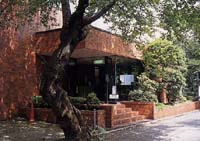 Location:
If you choose to visit the museum, you will need to take the lane to the left immediately after getting off the bus (bound for Kamakurayama Bus Terminal) at Asahigaoka (旭ケ丘) Bus Stop. After an 80-meter walk, you will see a modern, brick-walled building on the right.
Location:
If you choose to visit the museum, you will need to take the lane to the left immediately after getting off the bus (bound for Kamakurayama Bus Terminal) at Asahigaoka (旭ケ丘) Bus Stop. After an 80-meter walk, you will see a modern, brick-walled building on the right.Story: The museum opened in 1982 to preserve and display Munakata's works, woodblocks he carved for printing, his tools and related items. It also shows much of his life and activities.
Munakata Shiko (棟方志功, 1903-1975), a woodcut artist, was born in the city of Aomori in northern Japan. His family was so poor that he was only able to finish elementary school. Eager to become an artist, he moved to Tokyo in 1924, but in his early years was not successful.
One of his oil paintings, however, was accepted for the annual Imperial Art Exhibition (Teiten, 帝展, present-day Nitten,日展) in 1928. He soon turned to woodcut art and studied under Hiratsuka Un'ichi (平塚運一, 1895-1997), producing many woodcuts, watercolor and oil paintings, calligraphic scrolls, and many books. Among his numerous awards was the Order of Cultural Merit (文化勲章). His works are unique and popular here in Japan and abroad.
Munakata insisted on using the characters "板画" (hanga) for his works, rather than "版画," because the character "板" contains the radical for tree (木) and is therefore more appropriate to the materials he used.
| Shorenji Temple (青蓮寺) |
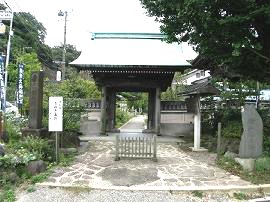
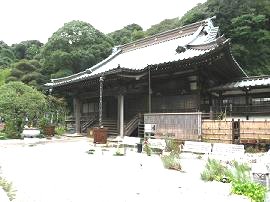
Full name: Hanjozan (飯盛山) shorenji
Denomination: Shingon sect (真言宗)
Location: The temple is near Nishi-Kamakura Elementary School and some 600 meters toward Nishi-Kamakura from the Tebiro crossroads.
History: The founding priest was Kukai, a.k.a. Kobo Daishi, and the restorer is said to have been Zenkai (善海, ?-1460). The temple once boasted some 30 sub-temples, including some close to Enoshima. Even now it has ten and is popularly called Kusari Daishi (鎖大師)
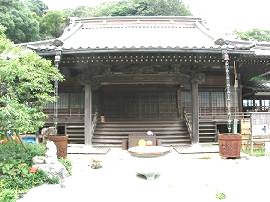
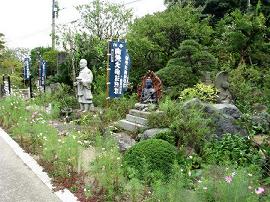
Grounds After you pass through the Sammon Gate, on which hangs a wooden plaque inscribed with the characters 準別格本山青蓮寺, which roughly translate as "Associated Head Temple," and "鎖大師遍照殿," Kusari Daishi Henjoden," literally, "Hall Ubiquitously Lit by Kobo Daishi."
The Main Hall is on the right. Though not open to the public, it houses a statue of Kobo Daishi, popularly called Kusari Daishi, literally, "Chain-Jointed Kobo Daishi," along with statues of Fudo Myoo and Aizen Myoo (愛染明王): Fudo is attributed to Chisho (智証), popularly called Enchin (円珍,814-891), in the Heian period; and Aizen is thought to be the work of Unkei (運慶, ?-1223) in the Kamakura period.
The statue of Kobo Daishi, probably made in the late Kamakura period, is designated an Important Cultural Property. The appearance is realistic, the image naked and wearing a priest's robe, and the fingernails are made of crystal and have a natural look because cinnabar underlies them to give the appearance of blood. Chains connect the knee joints so as to allow movement, an artifice employed to suggest that Kobo Daishi is always ready to go wherever he is called and is still actively saving people.
According to temple tradition, the statue was carved by Kobo Daishi himself in 816. Because he was ordered to go on a pilgrimage across the country by Emperor Saga (嵯峨天皇, 786-842), he allegedly left this image in place of himself for the Emperor, who would miss him. He made it, we are told, by observing himself in a mirror, and adorned the statue with a robe, a rosary, and other Buddhist paraphernalia. He then offered it to the Emperor. After the Emperor's death the statue changed hands: Okadera Temple (岡寺) in Yamato (now in present-day Nara Prefecture), Hachimangu Shrine, Jufukuji Temple (寿福寺) and finally its permanent place here.
Although a nude statue is rare in Kamakura, three others do exist: Benzaiten (弁才天) in Tsurugaoka Hachimangu Shrine, Migawari Jizo (身代り地蔵) at Emmeiji Temple (延命寺), and Benzaiten on Enoshima Island.
The temple has a mandala, which shows the Buddhist world of enlightenment, but it is now on loan to the Kamakura Kokuhokan in the grounds of Hachimangu Shrine.
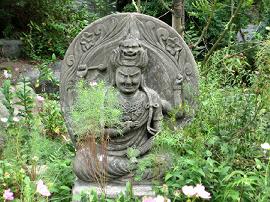
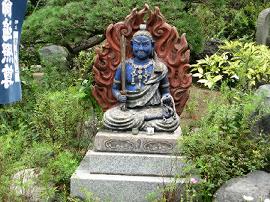
Story: In 819, when Kobo Daishi stayed here for 365 days, he held Buddhist services in which he lighted a holy fire for invocation. During one of the masses, a beautiful celestial being appeared to him and said, "I will attend on you and help your prayer."
On the day of the final mass, Daishi told the apparition that he was now finished. She then removed a piece of bone from under her crown, saying, "Bury this anywhere you would offer a prayer." No sooner did she say this than she vanished into a nearby pond. Daishi slept that night after putting the bone in a pot called gochibyo (五智瓶).
The next morning he found beautiful blue lotus flowers in the pond and discovered that it was filled with an elegant fragrance. He then remembered the strange words spoken by the apparition, and visited the island of Enoshima, where he built a sacred fire in her honor.
Later, he made a statue of Benzaiten, using the ashes from the fire. Because of this connection, the temple was named Shorenji, literally, "Blue Lotus Flower Temple."
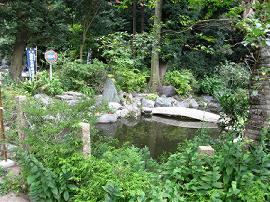
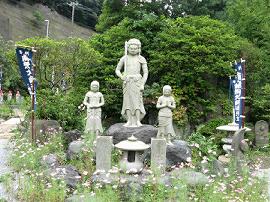
The pond, though now dwarfed to nearly a puddle, continues to be called Benten Ike Pond (弁天池). The spot where Daishi built the sacred fire is said to be the top of Mt. Hanjozan (飯盛山) behind the Main Hall. On the mountain are more than ten stone Buddhist images lining the path.
Areas: Yamasaki (山崎) and Kamimachiya (上町屋)
Place Name
Yamazaki got its name from the fact that this area is located "beyond" (先 or 崎, zaki or saki) Tejin' yama and other mountains (山, yama).Kamimachiya's name arose because this area was once called Machiya (町屋), which means a prosperous and bustling town. kami (上, upper) was added later.
| Kitanojinja Shrine (北野神社) |
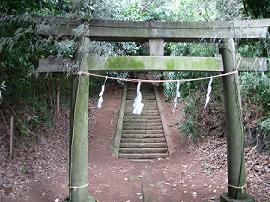
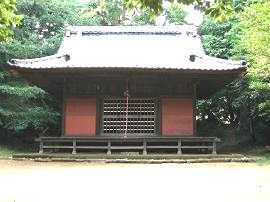
Location: Get off at Yamazaki Bus Stop from Ofuna on the bus bound for Enoshima or Kamakura, cross the road to the right, walk some 200 meters, and the approach to the shrine is to be seen on the left.
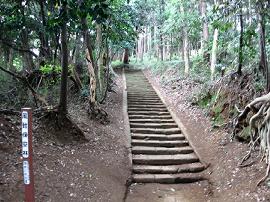
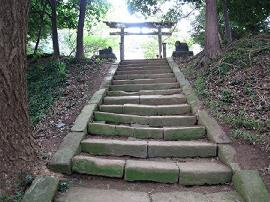
Grounds: Pass by a three-meter-high stone lantern and continue toward Tenjin'yama Mountain. This will bring you to a stone torii (鳥居) shrine gate inscribed with the era name天保四年 (corresponding to 1833). Beyond is a stone stairway of some two-hundred steps. The grounds are thickly surrounded by cedar trees, and this well-preserved area is designated A Forest Grown for Scenic Beauty (風致保安林). Once you ascend the stone steps and pass through a ryobu-style torii (両部鳥居), you will be at a courtyard where Haiden Hall (Worship Hall) stands. The shrine is dedicated to Sugawara no Michizane (菅原道真, 845-903), and its annual festival is held on September 25. Haiden Hall houses a mikoshi (神輿, portable shrine) dedicated to Gozu Tenno (牛頭天王).
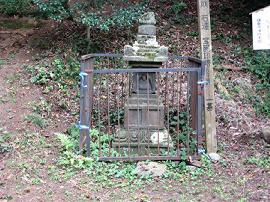
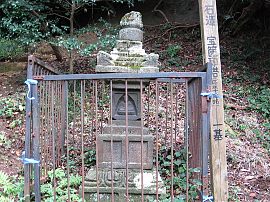
To the left of Haiden Hall is a hokyointo-type (宝篋印塔) stone monument. It is also called rishoto (利生塔), because it was erected for present as well as future happiness. The roof-like upper section has a depression, and the rainwater that accumulated there was believed to be curative of any disease of the eyes. The stupa is said to be very rare because a relief of Buddha appears on each of its four surfaces: Yakushi Nyorai (薬師如来), Shaka Nyorai (釈迦如来), Amida Nyorai (阿弥陀如来), and Miroku Bosatsu (弥勒菩薩), on the east, south, west and north faces respectively. On the lower ground behind the stupa stand two small stone shrines moved here from the area called Morondai (もろん台).
Tenjin'yama Mountain (天神山) has a leveled area on its eastern side, which was probably a dwelling site of ancient people because a number of pieces of earthenware have been found buried there. On the western side are the remains of a mountain fortress from the Kamakura (1185/92-1333) and Muromachi periods. A number of ditches thought to be fortress moats were found there. The entire area was strategically important from the military point of view.
History: The founding of the shrine dates back to a time between 1330 and 1340 in the Muromachi period (1336-1573) when Muso Soseki (夢窓疎石, 1275-1351) dedicated the deity of Kitano Temmangu Shrine in Kyoto here, because the location, southwest of Engakuji Temple, corresponded to an inauspicious direction from which evil was believed to enter and therefore had to be guarded.
The shrine prospered when it was built, but gradually went into decline. In the Edo period (1603-1867), it was made the guardian deity of the neighboring village, and its present festival date, sacred dancing performances, and offerings all date from that time.
| Shoseiin Temple (昌清院) |
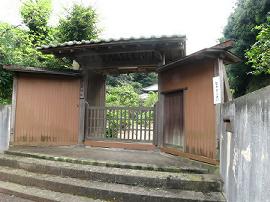
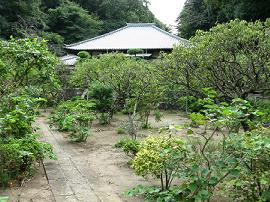
Full name: Sankisan (山崎山) Shoseiin
Denomination: Rinzai sect (臨済宗)
Location: Shoseiin is located some 170 meters south of Yamazaki Shukaisho Community Hall (山崎集会所).
History: The temple is said to be built in 1597 by a priest, Isoku Tokuman (以足徳満). Once the temple was deserted, but was rebuilt in 1970 as you see now.
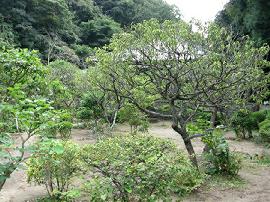
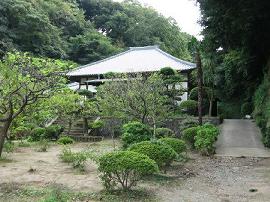
Grounds; The Main Hall houses a wooden statue of Shaka Nyorai (釈迦如来), and an image of Jizo which is among the ten Jizo in Kamakura. In the left corner is a bronze statue of Juichimen Kannon (十一面観音), one meter high, said to have been created by Kasuga (春日), a Buddhist sculptor.
To the right are nine statues of the Ten Kings of Hades (the tenth now preserved at Engakuji Temple), along with statues of Gushoshin (倶生神) and Datsueba (奪衣婆). Gushoshin is said to record conduct, both good and evil, from the time of one's birth, and to report it to Emma Daio (閻魔大王). Datsueba, on the other hand, robs people of their clothes at the bank of the River Styx.
Behind the Main Hall is a pond called Suribachi Ike (すり鉢池). Halfway up the hillside beyond the pond is a stone shrine called Tsubaki Benten (椿弁天) or Susaki Benten (洲崎弁天).
In 1333, Nitta Yoshisada (新田義貞, 1301-38) attacked Kamakura. When its defenders launched a surprise attack, he managed to escape by taking shelter at this shrine. Since then, the shrine has been worshiped as the guardian deity of Yoshisada.
| Senkoin Temple (泉光院) |
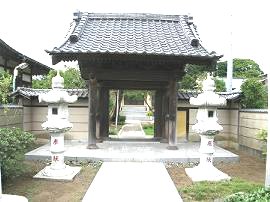
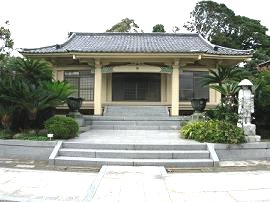
Full name: Tenshuzan (天守山) Senkoin
Denomination: Shingon sect (真言宗)
Location: To reach the temple, walk west from Shonan Machiya Station (湘南上町屋) on the Shonan Monorail Line, pass Mitsubishi Electric, Kamakura Factory (三菱電機 鎌倉製作所) to the right, and continue some 200 meters until you see the back gate of Fujizuka Shogakko Elementary School (富士塚小学校). Follow the road 300 meters and turn to the left when you arrive at a three-forked point. At the end of the lane is Senkoin.
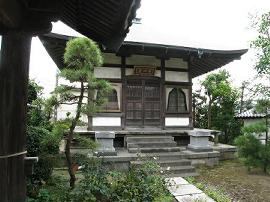
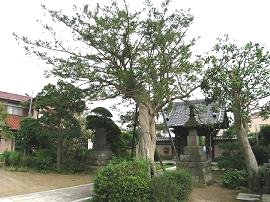
Grounds: The Main Hall houses statues of Amida-sanzon (阿弥陀三尊), Kobo Daishi (弘法大師, 774-835) and Fudo Myoo (不動明王). At the left rear of the Main Hall is Yakushido Hall, where Yakushi Nyorai is enshrined. Another hall is within the grounds and contains a statue of Jizo and a set of Six Jizo.
| Tenmangu (天満宮) |
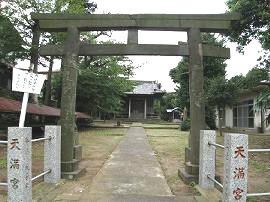
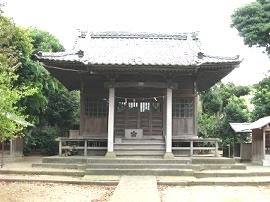
Location: Temmangu is located 50 meters south from Senkoin (above).
History: Tenmangu is a tutelary deity of the Kamimachiya area. The shrine was created in the Heian period (794-1185/92) by Taira no Yoshibumi (平良文), who was inspired by a divine message that came to him in a dream.
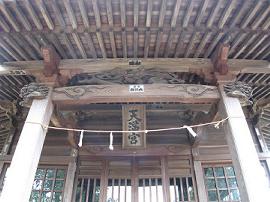
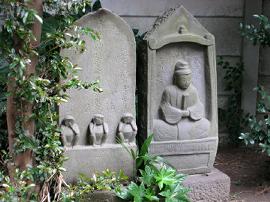
Grounds The myojin-style (明神鳥居) torii shrine gate at the entrance dates back to 1840. Structures that were built in 1781 consist of Haiden (拝殿), Worship Hall, and Honden (本殿), or Main Hall. The three shrines next to the main structures are dedicated to Umeo (梅王), Matsuo (松王), and Inari (稲荷), respectively. Though small, they nonetheless are structurally elaborate. Within the grounds stand a handful of stone monuments: a 1712 relief of Sugawara no Michizane (菅原道真, 845-903), a celebrated statesman and scholar of the Heian period; a koshinto (庚申塔) erected in 1670 with a relief depicting the three monkeys who see, hear and speak no evil; and a monument erected in 1864 for the worship of Mt. Fuji.